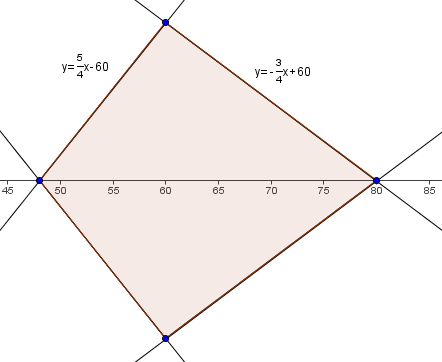Difference between revisions of "1987 AIME Problems/Problem 4"
m (Shoelace Theorem link) |
m (→Solution 2) |
||
| Line 20: | Line 20: | ||
Now, let us remove the absolute values: | Now, let us remove the absolute values: | ||
| − | When <math>x | + | When <math>x\ge 60</math>: <math>x-60+y=0.25x</math>. This rearranges to <math>y=-0.75x+60</math>. |
| − | When <math>0 | + | When <math>0\le x<60</math>: <math>60-x+y=0.25</math>. So <math>y=1.25x-60</math>. |
When <math>x<0</math>: <math>60-x+y=-0.25x</math>. So <math>y=0.75x-60</math>. | When <math>x<0</math>: <math>60-x+y=-0.25x</math>. So <math>y=0.75x-60</math>. | ||
Latest revision as of 16:25, 13 February 2024
Contents
[hide]Problem
Find the area of the region enclosed by the graph of ![]()
Solution 1
Since ![]() is nonnegative,
is nonnegative, ![]() . Solving this gives us two equations:
. Solving this gives us two equations: ![]() . Thus,
. Thus, ![]() . The maximum and minimum y value is when
. The maximum and minimum y value is when ![]() , which is when
, which is when ![]() and
and ![]() . Since the graph is symmetric about the y-axis, we just need casework upon
. Since the graph is symmetric about the y-axis, we just need casework upon ![]() .
. ![]() , so we break up the condition
, so we break up the condition ![]() :
:
 . Then
. Then  .
. . Then
. Then  .
.
The area of the region enclosed by the graph is that of the quadrilateral defined by the points ![]() . Breaking it up into triangles and solving or using the Shoelace Theorem, we get
. Breaking it up into triangles and solving or using the Shoelace Theorem, we get ![]() .
.
Solution 2
Since ![]() is the only present
is the only present ![]() "term" in this equation, we know that the area must be symmetrical about the x-axis.
"term" in this equation, we know that the area must be symmetrical about the x-axis.
We'll consider the area when ![]() and we only consider the portion enclosed with
and we only consider the portion enclosed with ![]() . Then, we'll double that area since the graph is symmetrical.
. Then, we'll double that area since the graph is symmetrical.
Now, let us remove the absolute values:
When ![]() :
: ![]() . This rearranges to
. This rearranges to ![]() .
.
When ![]() :
: ![]() . So
. So ![]() .
.
When ![]() :
: ![]() . So
. So ![]() .
.
By simple sketching, we see the shape that looks like the image in Solution 1 (graph it out and you'll see). We see that the partial area we seek in this part is the triangle with the vertices ![]() ,
, ![]() ,
, ![]() . This triangle has an area of
. This triangle has an area of ![]() .
.
Simply double the area and we get ![]() as our final answer.
~hastapasta
as our final answer.
~hastapasta
See also
| 1987 AIME (Problems • Answer Key • Resources) | ||
| Preceded by Problem 3 |
Followed by Problem 5 | |
| 1 • 2 • 3 • 4 • 5 • 6 • 7 • 8 • 9 • 10 • 11 • 12 • 13 • 14 • 15 | ||
| All AIME Problems and Solutions | ||
The problems on this page are copyrighted by the Mathematical Association of America's American Mathematics Competitions. ![]()










